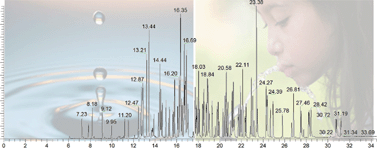Development of EPA Method 525.3 for the analysis of semivolatiles in drinking water†
Abstract
The United States Environmental Protection Agency's (EPA) Office of Ground Water and Drinking Water (OGWDW) collects nationwide occurrence data on contaminants in drinking water using the Unregulated Contaminant Monitoring Regulations (UCMRs). The unregulated contaminants, which are potential candidates for future regulation, may be selected from the Drinking Water Contaminant Candidate List (CCL), or may be emerging contaminants, with the potential for inclusion on future CCLs. In October 2009, OGWDW published the third Drinking Water CCL (CCL 3). Not all of the chemicals on CCL 3 are included in existing analytical methods with sufficient sensitivity and specificity for UCMR monitoring. Some of the chemicals that require method development research fall into the category known as semi-volatile organic chemicals (SVOCs). Currently, EPA Method 525.2 is used to measure SVOCs for both drinking water compliance and UCMR monitoring. The method utilizes C-18 solid-phase extraction (SPE) for contaminant isolation and concentration, followed by full scan gas chromatography-mass spectrometry (GC-MS) detection. A group of 27 contaminants from CCL 3, a list of chemicals from EPA's National Homeland Security Research Center (NHSRC), as well as other emerging compounds of interest, were evaluated for inclusion into a new revision of the method, EPA Method 525.3. Method improvements include: (1) utilizing a polymeric-based SPE sorbent for greater retention across sample pH range, (2) enhanced method sensitivity using GC-MS with selected ion monitoring (SIM), (3) safer and more user-friendly sample preservatives, and (4) sample preparation techniques that help overcome matrix-induced chromatographic response enhancement. To be used for nationwide monitoring, the new method must be rugged across a range of drinking water sources, sensitive and highly specific to minimize false positives. It must also be cost effective and simple enough for commercial lab settings. Accuracy and precision data using full scan GC-MS mode are presented for 125 contaminants. Multi-laboratory data obtained in selected ion mode (SIM) are presented for a subset of priority analytes. Lowest Concentration Minimum Reporting Limits (LCMRLs) of priority analytes obtained from four separate laboratories ranged from 0.0006 to 0.28 μg L−1, with an average LCMRL of 0.035 μg L−1 and median LCMRL of 0.011 μg L−1, under SIM conditions.


 Please wait while we load your content...
Please wait while we load your content...